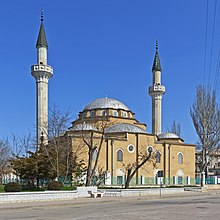
Summary
The Juma-Jami Mosque, (Ukrainian: Мечеть Джума-Джамі, Crimean Tatar: Cuma Cami, Russian: Мечеть Джума-Джами, Turkish: Cuma Han Camii) also known as the Friday Mosque, is located in Yevpatoria, Crimea.[2] Built between 1552 and 1564, and designed by the Ottoman architect Mimar Sinan.
| Juma-Jami Mosque | |
|---|---|
 | |
| Religion | |
| Affiliation | Islam |
| Rite | Sunni |
| Status | Active |
| Location | |
| Location | Yevpatoria |
| State | Territory of Ukraine, occupied by Russia[1] |
| Territory | |
| Geographic coordinates | 45°11′45″N 33°22′38″E / 45.19583°N 33.37722°E |
| Architecture | |
| Architect(s) | Mimar Sinan |
| Type | Mosque |
| Style | Ottoman architecture |
| Completed | 1564 |
| Specifications | |
| Direction of façade | North |
| Dome height (outer) | 20 meters |
| Dome dia. (outer) | 6 m (20 ft) |
| Minaret(s) | 2 |
| Minaret height | 35 meters |
| Materials | Limestone |
History edit
The Juma-Jami is the largest mosque of Crimea and was founded by Khan Devlet I Giray in 1552. The Khan commissioned Istanbul architect Mimar Sinan (1489–1588) to build the mosque.[3] Sinan was the chief architect of the Ottoman Empire. He designed the Sinan Pasha Mosque and the Şehzade Mosque in Istanbul. Construction of the Juma-Jami Mosque was a long process. At the time, Mimar Sinan was busy with construction of the Süleymaniye Mosque, in Istanbul, which was also plagued by financial difficulties due to money being spent on a war with Ivan the Terrible.
The mosque continued to be embellished and improved over time. From 1740 to 1743, the mosque was rebuilt and the main building was restored; from 1758 to 1769, the western facade of the mosque was decorated with paintings.[4]
Photos edit
-
Main entrance to the Juma-Jami Mosque
-
-
-
-
-
See also edit
References edit
- ^ This place is located on the Crimean peninsula, which is internationally recognized as part of Ukraine, but since 2014 under Russian occupation. According to the administrative-territorial division of Ukraine, there are the Ukrainian divisions (the Autonomous Republic of Crimea and the city with special status of Sevastopol) located on the peninsula. Russia claims these as federal subjects of the Russian Federation (the Republic of Crimea and the federal city of Sevastopol).
- ^ "Yevpatoria : The Juma-Jami Mosque". discover-ukraine.info. Retrieved 2023-03-17.
- ^ Pleshakov, Konstantin (2017-01-01). The Crimean Nexus: Putin's War and the Clash of Civilizations. Yale University Press. p. 72. ISBN 978-0-300-21488-8.
- ^ Sementsov, Sergey; Leontyev, Alexander; Huerta, Santiago; Nava, Ignacio Menéndez Pidal de (2020-09-24). Reconstruction and Restoration of Architectural Heritage. CRC Press. p. 77. ISBN 978-1-000-32978-0.
External links edit
- Han Camii, Archnet


